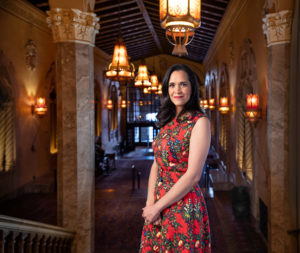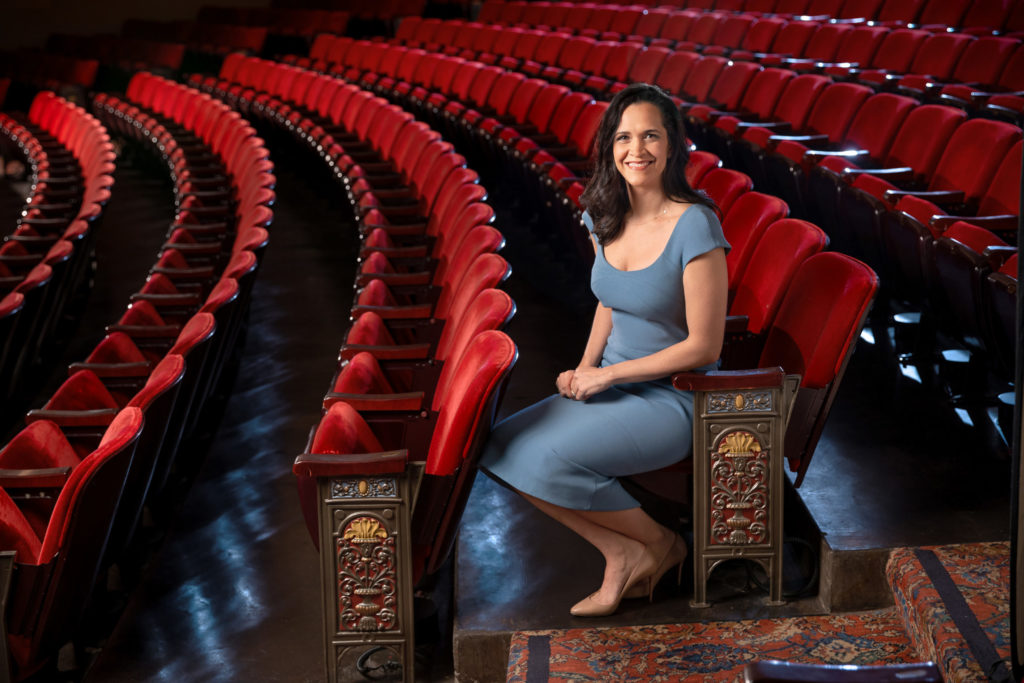
Returning Home – How Khori Dastoor Went From Resident Artist to General Manager at Opera San José
By David Salazar(Credit: John Hardy)
Back in early April 2019, the Opera San José Board of Directors announced that Khori Dastoor would be taking over as General Manager.
The announcement was the culmination of a unique relationship that saw Dastoor rise from performer to manager in just a little over a decade.
Irene Dalis’ Call
Back in 2007, Dastoor was a soprano working on her Doctorate degree in UCLA when legendary singer and founder of Opera San José Irene Dalis reached out and invited her to become a resident artist with Opera San José.
“I didn’t know anything about it at the time,” Dastoor told OperaWire in a recent interview in anticipation of the company’s announcement of the 2020-21 season, the first under Dastoor’s leadership. “Irene told me that they ran a European-style festhaus in San Jose. ‘Come and see if you want to be an opera singer instead of being a waitress,’ she told me.”
Dalis’ pitch included having Dastoor take on the roles of Lucia in Donizetti’s “Lucia di Lammermoor,” Pamina in “The Magic Flute,” Gilda in “Rigoletto,” and Sophie in “Werther.”
She had never seen anything like it. And neither had her closest mentors.
“I called my coach and professors and voice teachers and nine out of 10 of them said it was a terrible idea,” Dastoor revealed.
But there was one person that wasn’t so quick to strike down the proposal – Vladimir Chernov. The famed baritone’s lone question to Dastoor centered on the size of the theater. When she told him that it was a 1,100-seat house, he didn’t hesitate to tell her “You can do it.”
It proved the perfect environment for Dastoor to build up her career as a singer, and in her year with the company she learned not just what worked for her, but what definitely wouldn’t.
“It surprised me the roles that were really right and the ones that weren’t,” she noted before adding that the program gave her the tools to take her career farther than she could have imagined. “Because I sang Lucia here, I sang it in Europe. I would never have had that opportunity anywhere else.”
The catalyst for this development is the entire philosophy and structure implemented by Opera San José’s resident artist program, which Dastoor looks to continue championing under her leadership.
“In America we have this eternal young artist model where people are constantly proving themselves over and over again. They go from young artist to being a cover, and do this until they are in their 40s. And then we ask where is the future? At Opera San José, the focus was on creating that future now, giving singers an opportunity to go out and have careers in leading roles,” she noted. “I was really influenced by the idea of a resident model. The idea that artists need places where they can feel safe and explore, in order to hone all the other skills besides the voice. How do you become someone that someone wants to look at for three hours? How do you become someone who knows how to check in with maestros through your peripheral vision and do the costume change and handle the letter and get a drink of water when no one is looking? The answers is a lot of rehearsal and a lot of performance, to give people tools that they can use. That’s what we do here.”
As a soprano, Dastoor performed with such companies as the Los Angeles Opera, Aspen Music Festival, the Lake George Opera, the Los Angeles Master Chorale, the American Youth Symphony, Switzerland’s Luzerner Theater, and the Presidential Symphony Orchestra of Turkey, among others, in operas by Mozart, Verdi, Britten, Humperdinck, and Donizetti.
And then she closed that chapter in her life and turned the page to something different.
“I had a great regional performance career and then was ready for what was next,” Dastoor noted.
Leaving & Returning Home
For the soprano, making that decision to shift into a different capacity required a great deal of thinking.
At the Packard Humanities Institute, she started off editing Mozart scores as part of a Digital Mozart Program that coded the famed composer’s scores to make them searchable and printable.
Eventually, she took a Grants Administrator position before eventually becoming Associate Director, where she would look at proposals from arts organizations and advise them on how to execute plans.
“As a foundation, you have a vested interest in getting things done in a way that might push the grantee to improve as an organization,” Dastoor noted. “Implementing best practices, setting up metrics, figuring out what the deliverables might be.”
She thought her career would end there. Then she got another call from Irene Dalis.
Dalis was in a car accident in 2010 that left her with broken ankle. It also left her needing help with her work at Opera San José as she was struggling to get to auditions and other major assignments she had at the helm of the company.
Dastoor was still working in her grants capacity and was fully committed to the endeavor. But she couldn’t say no to Dalis, and so the Packard Humanities Institute donated 10 hours of her time to be an artistic advisor to Opera San José and assist in the casting process.
It was not supposed to be a long-term gig, but as Dastoor put it: “It never went away.”
When Larry Hancock took over as General Manager, Dastoor remained an artistic advisor. She was firmly embedded in the company’s DNA at that point, a major part of its team.
So when Hancock decided that he was ready to retire from his position, Dastoor was invited to lunch in late 2018 by the long range planning committee; the people she spoke with at that lunch had known her since her time as a singer. They told her she was being considered and asked if she was interested.
She was given a weekend to think about it. That’s all she needed.
“It was the opening weekend of ‘Pagliacci,’” she narrated. “It is hard to think of music that I love more. I listened to this production, in which I had been so involved with casting and role debuts. It was in this moment that my dream became clear, listening to these people who were better than I ever was, and realizing I had the privilege of being able to participate in giving them this opportunity. They sang their faces off and the orchestra sounded amazing.”
“And I felt in that moment that this is what I wanted.”
She broke the news to her boss at the foundation and found a great deal of support. She then went and proposed her vision to Opera San José’s board, which really came down to making a radical shift in the company’s direction, the foundation, and the residency program. Her timeline was then accelerated from Jan. 1, 2020 as her start date, to Oct. 1, 2019.

(Credit: John Hardy)
A Need for Change
For Dastoor, the future of the company requires a shift from past practices. While she recognized that she was inheriting an important legacy from a legendary founder, including a “mini-Met” that has its own costume staff and a scene shop where productions are built, Opera San José has “not been well-integrated into the fabric of American opera companies. We have not been on the radar.”
Further accentuating the company’s loss of visibility is a mounting deficit and plummeting subscriber base which she numbered at around 3,100, down from 5,100 a few years back. In doing a full company assessment when she kickstarted her tenure, she found that, among other issues, the company had not kept pace with certain industry standard pay practices, particularly for chorus members.
Dastoor issued a letter to all company artists noting that she was committed to improving the situation and that “choristers will henceforth be categorized as independent contractors, base chorus compensation will be increased, and more detailed contracts will be put in place to align with industry best practice standards.”
“If we think as a company that we can suppress expenses to survive, we are wrong,” she noted. “We have to instead be bold and grow. There has been a strategy of looking at every line item and looking for 20 percent. I just don’t see how that works anymore.”
In order to deliver a new strategy and artistic vision, she also restructured the team surrounding her with James Williams, the company’s former CFO and Managing Director of Finance & Administration shifted to overseeing Human Resource policies and procedures. She brought in Monica Thakkar as the new Director of Music and Artistic Administration as well as Eugénie Bramley as Artistic and Music Coordinator; Christopher Ray, the company’s first Resident Conductor is now the new Chorus Master. Finally, Claire Padien-Havens joined as Managing Director of Institutional Strategy.
“I feel honored by their leap of faith and willingness to put it on the line.”
Dastoor noted that in terms of building the company’s structure, over $850,000 in launch funds have been raised and she was optimistic that this number would grow with other artistic initiatives the company would set forth.
Among her major artistic initiatives is developing the resident program to ensure that artists are getting opportunities to build their careers.
“We want a flexible model of giving singers multi-year contracts so they have stability and a place where they are coming and going,” she noted, adding that she wants the artists to also feel free to take other auditions and projects. “I measure our success by that ability to unlock the door. Did that opportunity furnish a future opportunity for that artist somewhere else? That is what it was able to do for me and I want it to do even more for other artists.”
Then there is the question of repertory, which Dastoor wants to revamp, providing the local community with something truly unique that they can’t find anywhere else. To this point, the company is seeking out opportunities to interact more directly with the community through panel discussions with local scholars and collaborating with organizations on projects.
This can be seen in the company’s recent announcement that its upcoming production of “Carmen” would feature collaboration with the Flamenco Society of San José. The company will also be performing its first-ever opera by Richard Strauss in “Salome,” which will be directed by Matthew Ozawa. Dastoor noted that in engaging with the German composer for the first time, she wanted the audience to have a truly unique and challenging experience.
“Salome is destroyed because she does something in public, not in private,” Dastoor noted about the ideas behind this new interpretation. “And I want to challenge my audience members to understand their culpability for participating in this evening. Activating the lobby and playing with seating on and offstage, where singers are. Putting cameras onto the backstage. All of it to take away the comfort of backstage and front of house. It is like a gladiator-style situation where we all sit there and witness this woman’s destruction. There is no comfort of sitting in a seat in a dark room.”
The company has also never done a musical, a fact that it will remedy with Bernstein’s “West Side Story,” which Dastoor noted was her personal favorite.
And then there is the season opener, which is always a major statement of intent – a production of “Le Nozze di Figaro” set in Colonial India during Victorian Imperial Rule. Dastoor, whose father is from India, had always wanted to see the famed Mozart and Da Ponte opera set in this particular time and place and felt that it was a perfect fit for Opera San José for a number of reasons.
The first of these was the possibility of reaching a vibrant Southeast Asian community that lives in the area. And the second was the possibility of casting with “ears and eyes.”
To this effect the opera will feature Indian American sopranos Maya Kherani as Susanna and Indira Mahajan as Marcellina.
But Dastoor also noted that this period of time featured a wide array of different people in Colonial India, including Portuguese, Africans, and even Syrian Christians. As such, she has Efraín Solis as Figaro with the Count and Countess portrayed as White immigrants by Maria Natale and Eugene Brancoveanu.
Finally, she feels that the context of the story adds a unique layer to the Figaro story.
“For the first time, British delegates were going over with the idea of never returning,” she revealed. “And they were often not necessarily the best and brightest that went. They were ex-pats in a foreign jungle, not knowing the language, not knowing the culture and yet despite being at the mercy of incredibly powerful forces, they were somehow supposed to be ‘in charge.’ I have always been fascinated by the isolation of Countess Almaviva throughout the work, and this context heightens that isolation. And then there is this idea of the Count whose life perhaps has not gone the way he once had hoped. This relocation affords him a new opportunity to begin again and perhaps assume some degree of power o r domination in a new place, but of course, his self-doubt and disappointments follow him across the oceans.”
Dastoor also revealed a number of other unique initiatives which will be unveiled publicly at a later date. She admitted that there will be a great deal of experimentation in the early going because there is still a lot to learn about how Opera San José will establish itself in the new opera landscape of the region. But she maintained optimism in bringing change.
“I see it as a wonderful opportunity and challenge,” she concluded. “We don’t have the same bureaucracy and intense financial restrictions as bigger companies and I plan to use it to our advantage, even though it is a little scary. We don’t have as many tickets to sell or dollars to raise and I am glad to be in a more nimble place as we better serve a really diverse community in San Jose.”


